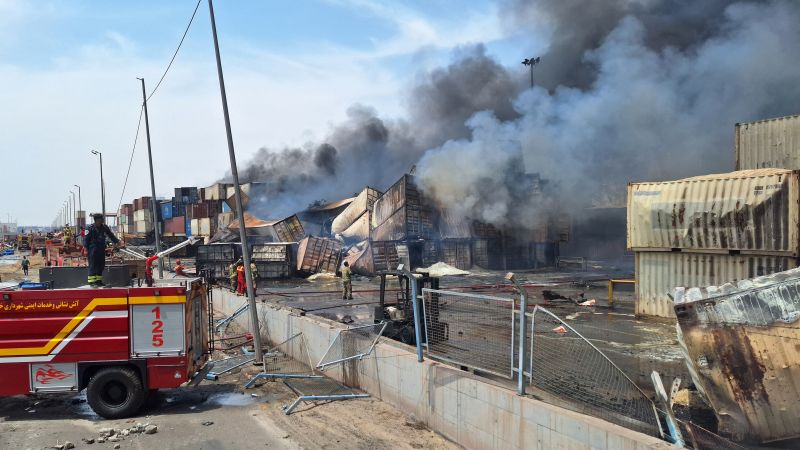Iranian authorities have not said what caused the massive explosion at the port of Bandar Abbas on Saturday, killing at least 28 people, but video footage and unconfirmed reports point to the possible presence of a chemical used to make missile propellant. Eyewitness accounts and video indicate chemicals in an area of shipping containers caught fire, setting off a much larger explosion . The death toll spiked sharply following the incident, with 800 others also reported injured.
One surveillance video distributed by the Fars news agency shows a small fire beginning among containers, with a number of workers moving away from the scene, before a huge explosion ends the video feed. CNN has previously reported that hundreds of tons of a critical chemical for fueling Iran’s ballistic missile program arrived at the port in February. Another shipment is reported to have arrived in March.

The state-run Islamic Republic News Agency quoted an official as saying the explosion was likely set off by containers of chemicals, but did not identify the chemicals. The agency said late Saturday that the Customs Administration of Iran blamed a “stockpile of hazardous goods and chemical materials stored in the port area” for the blast. Iran’s national oil company said the explosion at the port was “not related to refineries, fuel tanks, or oil pipelines” in the area.
Iranian officials have denied that any military materiel was held at the port. The spokesman for the national security and foreign policy committee of the Iranian parliament, Ebrahim Rezaei, said in a post on X Sunday that according to initial reports the explosion had “nothing to do with Iran’s defense sector.” The blast comes at a time of high tensions in the Middle East and ongoing talks between Iran and the United States over Tehran’s nuclear programme, but no senior figure in Iran has suggested the blast was an attack.
Videos and images from the scene, some of which have been geolocated by CNN, show orange-brown smoke rising from part of the port where containers were stacked. Such a color would suggest a chemical such as sodium or ammonia was involved. Fires at the port were still burning Sunday, although Iranian state media said they were 80% contained.
The New York Times reported Sunday that a person “with ties to Iran’s Islamic Revolutionary Guard Corps said that what exploded was sodium perchlorate, a major ingredient in solid fuel for missiles. The person spoke on condition of anonymity to discuss security matters.” CNN cannot confirm what was being stored in the area at the time of the explosion and it is unclear why such chemicals would be kept at port for so long.
In February CNN reported that the first of two vessels carrying 1,000 tons of a Chinese-made chemical that could be a key component in fuel for Iran’s military missile program had anchored outside Bandar Abbas. The ship, Golbon, had left the Chinese port of Taicang in January loaded with most of a 1,000-ton shipment of sodium perchlorate, the main precursor in the solid propellant that powers Iran’s mid-range conventional missiles, according to two European intelligence sources who spoke with CNN. Sodium perchlorate could allow for the production of sufficient propellant for some 260 solid rocket motors for Iran’s Kheibar Shekan missiles or 200 of the Haj Qasem ballistic missiles, according to the intelligence sources.
The Chinese Foreign Ministry told CNN in February that “China has consistently abided by export controls on dual-use items in accordance with its international obligations and domestic laws and regulations,” adding that “sodium perchlorate is not a controlled item by China, and its export would be considered normal trade.”.
Business

Iran tight-lipped on cause of deadly port explosion amid reports of possible presence of chemicals used to fuel missiles
















